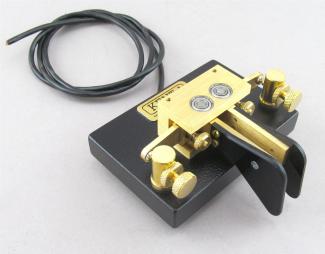Occasionally, our customers ask: “What is Iambic Keying?”
Iambic keying is an advanced CW skill that takes practice and time to master, but once learned reduces operator fatigue and may allow a modest improvement in sending speed.

Kent Morse Keys Twin Paddle Key TP1-B
Iambic keying requires a dual lever paddle such as the Kent Morse TP1-B Twin Paddle Key.
One lever is dedicated to sending dits, and the other lever is dedicated to sending dahs. Iambic keying involves squeezing both paddles – the first paddle to make contact sends its element (dit or dah) immediately followed by the opposite element. This continues as long as one or both paddles are squeezed. This allows many CW characters to be sent more efficiently.
For example, the letter C can be sent by squeezing both paddles with the dah paddle making contact first, then holding both paddles until the letter C has been sent. The keyer will send dah-dit-dah-dit (C) and once the final dit is sent, you release the paddles. Similarly, the letter F can be sent by pressing the dit lever and holding it until the second dit is sent, then tapping the dah lever momentarily to insert the dah while still holding the dit lever to send the final dit then releasing the lever. The keyer will send dit-dit-dah-dit (F).
There are a number of characters in the alphabet that can be sent more efficiently with iambic keying.

Kent Morse Keys Single Paddle Key SP-1
Non-Iambic keying can be done with a single lever paddle such as the Kent SP-1 Single Paddle Key.
Moving the lever one way creates dits, and moving it the other way produces dahs.
However, a dual lever paddle can also be used for non-iambic keying as long as you avoid squeezing the paddles and simply “slap” the paddles from side to side. If you are considering iambic keying, this would be a way to develop your iambic keying skills off the air, while using the dual paddle in a non-iambic fashion until you are ready to go live with iambic keying.
Remember, no matter what type of keying you prefer, DX Engineering has a code key or keyer paddle for you.


Pingback: Final review of the CommRadio CTX-10 QRP general coverage transceiver | The SWLing Post
Pingback: From the SWLing Post: A final review of the CommRadio CTX-10 QRP transceiver | Q R P e r